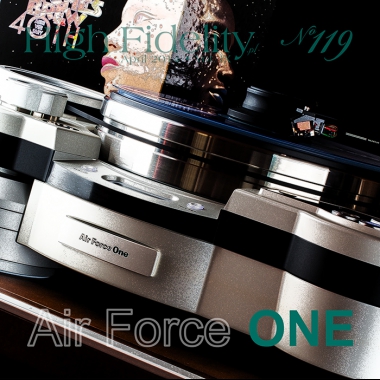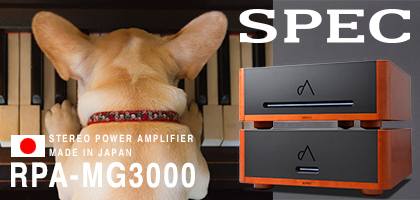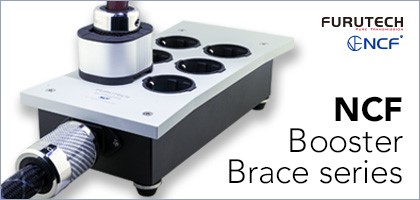No. 257 October 2025
- COVER REVIEW: ANCIENT AUDIO Silver Grand Mono Mk II ⸜ power amplifier • monoblocks » POLAND • Kraków
- KRAKOW SONIC SOCIETY № 153: 30 years of ANCIENT AUDIO » POLAND • Kraków
- FEATURE ⸜ music & technology: HISAO NATSUME presents - In search for the lost great pianism Chopin tradition » part 2 (France) » JAPAN • Tokyo
- REVIEW: AUDIOPHONIQUE Classic AP 300D ⸜ power amplifier » POLAND • Pruszków
- REVIEW: AVATAR AUDIO Holophony No. 1 ⸜ loudspeakers • floor-standing » POLAND • Osowicze
- REVIEW: DIVALDI Gold PA One ⸜ integrated amplifier » POLAND • Kraków
- REVIEW: J.SIKORA Aspire ⸜ turntable (deck + tonearm) » POLAND • Lublin
- REVIEW: MB AUDIO CABLE Silver ⸜ analog interconnect ⸜ RCA » POLAND • Turza Śląska
- REVIEW: XACT N1 ⸜ LAN switch » POLAND • Wrocław


|

|
|
WHERE IS THE MUSIC?


MOCAK is not a good museum. To be honest, it’s hard to say that it’s a museum at all. The works collected inside thus far could easily fit into a small anteroom of an average art collector’s house. But aside from the numbers, the quality of the works exhibited there makes it seem more like a prelude to an actual collection that may materialize someday. And you don’t have to go far to see a good example of a modern Polish art gallery – just visit the Polish Modern Art section of the National Museum in Wroclaw (see HERE), where the fantastic Abakans, Hasior’s installations, Beksiński’s reliefs and the works of other great people from the past 50 years have been placed next to each other. My wife and I particularly like Eugeniusz Get Stankiewicz’s “Zrób to sam” (“Do it yourself”) installation, which you have to see live, however creepy it may sound since Get Stankiewicz unfortunately passed away in 2011 (in Wrocław). 
While still being part of the exhibition, there’s a room that lets you breathe – there are giant prints of photographs made by Wojciech Plewiński in 1962 hung up all over the walls, which portray the artist in his first workroom in the Borek villa in Zakopane. Hasior, 34-years-old at the time, according to the museum’s materials, looks more like a sportsman than an artist on them. Furthermore: “No wonder, a decade prior he was a fervent runner and won the Polish championship on 1.5, 5 and 10 thousand meter distances several times, and even became a member of the national running team. But now the walls and floors of his workroom are covered by dozens of works that show that he’s been intensively living in a different world, created by himself, for a long time now. According to the proclaimed creed: “To me, the basic and strongest forces that produce the works of art are: intuition, imagination and fantasy”. The photos help researchers complete the artist’s posterity; incomplete and largely destroyed. As the art curator Józef Chrobak told the “Rzeczpospolita” magazine: “Hasior created almost 1,500 works, of which around half should have been preserved. In the catalogue, which is scheduled to be released in March, we’ll also present 80 of his lost works that we’ve been able to recover thanks to the photographs.” (Monika Kuc, Hasior kipiący emocjami, Rzeczpospolita 18.02.2014, see HERE). 
And it’s in one of those pictures that I saw black records. My initial reaction was exactly the same as that of the author of an article published in the cultural section of “Gazeta.pl”, i.e. that they must be raw materials, “prefabricated elements” of his future creations. And that’s because it’s “Difficult to count, how many there were forks, mirrors, tin forms, glass bulbs, vinyl records, broken violins, porcelain, crystals, pieces of clothing, dolls, Holy Mary figurines, sugar Easter lambs, knives or hair. They’re what the artist used to create his surrealistic sculptures.” (Małgorzata I. Niemczyńska, Wielki powrót Hasiora w MOCAK-u, “Co jest Grane” 17.02.2014, see HERE). Evenly aligned like dishes in a washing machine they looked like another art installation. Especially since in the front you could see big 78 rpm shellac “transcription discs”, used in radio stations back in the day. But what changed my perspective was the next photo, which showed the other side of the artist’s room. The table where his works were created was cluttered with singles, LPs and sound postcards. But they weren’t parts of his new works. Right next to them was a large tube radio, and behind it – a ready to play turntable, one of the predecessors of the Bambino. Why not the Bambino? Because Fonica didn’t launch the WG 252 Bambino before 1963. Hence, it was probably the GE56 from 1959. 
It so happens that the GE-56, and the Bambino that was based on its design, became a symbol of the 1950s and 1960s in Poland. Please look at any photo album, story, or anecdote collection that has the words “People’s Republic of Poland”, “iconic”, or “the 60s” in its title, and it’s nearly certain that one of the chapters will be dedicated to this turntable.  NOTHING BUT MUSIC Maria Peszek 
Jezus Maria Peszek. Niepotrzebne skreślić,Maria Peszek’s CD released in 2012 (its vinyl edition was just released, and will be reviewed in April’s “High Fidelity” edition) shocked and outraged many people. A public proclamation of her lack of faith, a declaration of her alter patriotism, couldn’t be liked in a country where religion is a subject forced upon students all the way up to high school. You can say all you want about how much you believe – but you can’t do the same about non-believing. Musically speaking, the album was perfect. The lyricism of Peszek’s first album, miasto mania (2005), combined with the dynamics and feistiness of the second one, maria Awaria (2008) has been distilled into something greater than both of them. Into pure energy. The most important thing were the lyrics, of course, there’s no doubt about that. JEZUS is aLIVE is something completely different or actually parallel to JMP, and these two albums complement each other. The material it contains (thankfully, no breaks in between tracks) mainly comes from Peszek’s third release, but at the end she also sings a few tracks from her second and her debut album. And one cover. You need to have balls to sing your own version of Personal Jesus by Depeche Mode – a track that was missing from the only tribute album to this band, For The Masses (2008), featuring artists like: The Smashing Pumpkins, The Cure, Vercula Salt (a lovely version of Somebody!), Deftones or Rammstein. None of the aforementioned bands had the guts to play Personal Jesus. The only artist whose version I can somewhat tolerate is Marilyn Manson. Peszek’s cover is coherent with the rest of the album, which gives it the strength it wouldn’t have as a stand-alone track. It defends itself quite well (I wonder how many people know that the song’s lyrics are inspired by the diaries of Priscilla Presley and refer to her life with Elvis, her “personal Jesus”, around whom everything turned?). 
Punk rock on stage and punk when recorded – that’s how you could sum this release up sound-wise. The aesthetics are connected to its energy and presentation, meaning all the WHAT comes together with the HOW. The sound isn’t particularly selective or resolving. Peszek’s vocals are set up on nearly the same plane as the drums, often merging tonally, too. The planes are large, which is nice, and that’s thanks to boosting the range below 500 Hz, in a rather wide spectrum. The bass goes down really low, especially when the synthesizer comes in. And it’s the synthesizer and acoustic guitar, which for example sounds really nice on Marznę bez ciebie, seem best-recorded and produced, almost as if they were refined in the studio. I’m assuming that’s not the case, as it’s much simpler to record something straight from line output rather than with a microphone, but it still sounds like that. It’s a fantastic album – the sort that I’ll listen to many more times. It includes everything I expect from music: energy; emotion; presentation; a second, third, and further meanings beyond that, the sort you only dig through to after playing the whole album several times. It contains mystery that doesn’t reveal itself fully from the get-go. And the sound? It’s not world class and it’s not even very well produced. But you can tell that what matters is the concert and the people who attended it. And that, in turn, is part of its credibility. Sound quality: 6/10 (but 10/10 for the music)  DAVID CROSBY 
There are some artist’s names that become synonymous with the bands they are in. Separately, they seem like an aberration and something not entirely understood. It seems that this is the case with David Crosby. This musician, born in Los Angeles in 1941, has been remembered by most people as a member of The Byrds and Crosby, Stills and Nash. He recorded 13 albums with the former and 17 with the latter (including Crosby, Stills, Nash and Young, as well as Crosby and Nash). So maybe it’s not strange at all that his 8 solo albums seem like more of a supplement. I think that Croz, his latest solo release, won’t change that, even though it’s a very successful album. Out of the 11 album tracks, three are ready for instant radio airplay, followed down the line by a few others. There are no weak tracks on this album – just very good and good ones. Croz was recorded in several studios, and you can tell. Doug Sax, the really talented man responsible for the mastering, did a great job in combining all of it into a smooth, coherent piece. Still, you can identify two groups of recordings – fuller, fatter ones with tangible sound sources, and the more distanced ones with less energy. In the former group, I’d include: What’s Broken, Holding On To Nothing, The Clearing (one of the best tracks on the album), If She Called and Find A Heart. The following would be in the latter group: Time I Have, Radio, Dangerous Night, Morning Falling (another track that will stay in your mind after listening to it merely once). Somewhere in between would be Slice Of Time and Set That Baggage Down, which feature slightly recessed vocals, but guitar and bass are as strong and meaty as in the first group. I’d place them in a sub-group of the second group. 
The whole thing sounds as if it were ran through a tube emulation device (or plug-in). Warm, soft and close, without a clear focus or precise definition. The resolution isn’t bad, although it doesn’t really reach further than presenting the timbre of particular sound sources. The acoustics and spatial effects are barely defined and covered up by direct sounds. The mid- and upper bass is strong, energetic and fat, and it’s what sets the “tone” for everything. Its control isn’t very good, though. But the most prominent still seems to be the vocal production, which is most important here. You can tell that it was the focus of sound engineers and producers, and it worked for the most part. Crosby’s vocals grab your attention with their warmth, intonation and smoothness, and the entire album sounds smooth and sensual. Maybe the face that features on the album cover has been touched by drugs and alcohol, but the voice is still unmista
Sound quality: 7-8/10  BOKKA 
The music of this Polish band is called “alternative”. I think the only time it could have ever been alternative was in the days of classic 4AD era greatness, while now it is nothing but mainstream. What is alternative, however, is the way the band presents itself – nobody knows who plays in it. It’s presumed that there’re two men and a female vocalist. It’s not a new concept, because this is exactly how the Daft Punk duo works, but it’s still attractive. 
Until recently, “home production” made me think of crappy demo recordings. But nowadays when the most expensive part of the studio, i.e. the recorder and mixer, can be “fired up” on nearly any computer, the situation has changed completely. The most important are now the microphones (if we’re talking vocals) and the skills of the person recording and producing the given music material. And, of course, the person responsible for mastering. Bokka, which has prepared this way, is not only good and interesting musically but also attractive sonically. Compared to, for example, Peter Nooten’s last two albums, Here is why and Surround Us, which were produced by the formed Clan of Xymox member in his own home, on an Apple computer, it’s not that hard to tell that the Polish album has a better tonal balance and is richer internally. There is no irritating brightening in the upper midrange or shallow, plastic pulse. On the other hand, the Polish album isn’t as dynamic as Portishead’s debut album, Dummy, which sometimes resembles a demo tape. The trip-hoppers’ album has better depth and isn’t as flat. The compression on Bokka seems a lot higher. You can’t really say much about a clear definition of the sounds and vocals. But I still think that this debut wonderfully fits the aesthetics of electronica and sounds even better than Kamp!’s debut. Sound quality: 6/10 SUZANNE VEGA 
|
Tom's Diner by Suzanne Vega, an American singer born in 1959, was a real hit. The track that featured on the disc accompanying “Fast Folk Musical Magazine” in 1984, is still played on the radio (it was later included on Vega’s 1987 album Solitude Standing). But it does have a dark side, at least to audiophiles. It was used by Karlheinz Brandenburg in his research on digital audio coding that contributed to the creation of the MP3 (Moving Picture [Expert Group Level] 3 [Compression]) lossy audio format by the famous German Fraunhofer Institute. The format itself has become (in)famous for its destructive effect on sound. Of course, that’s one way of interpreting this ground-breaking technology. Another one emphasizes the role that the MP3 played in spreading music to the masses and its migration onto computer systems. It is said that without MP3s there would be now no high-res audio files, because there would be no market for them. But you cannot keep quiet about either the MP3, or Tom’s Diner. The song’s author recorded her first album (Suzanne Vega) in 1985. Tails From the realm of the Queen of Pentacles is the eighth album in her career that has been going on for thirty years now. My personal favourite is Nine Objects of Desire from 1996, which includes the wonderful Caramel. For many years, starting from 1983, the artist recorded for the A&M Records label (current owners of the Universal Music Group), whose catalogue include albums by such artists and bands as Burt Bacharach, The Carpenters, Quincy Jones, Liza Minnelli, Wes Montgomery, Paul Desmond, Cat Stevens, Joe Cocker, Procol Harum and Sting. That’s just an excerpt from the vast catalogue, but it does give you a good idea of the company in which Vega found herself (at least in the catalogue). However, in 2006 she changed labels and a year later she released Beauty & Crime for the Blue Note/Capitol label company. Suzanne Vega’s albums were known for their excellent sound – she was quite lucky with sound and mastering engineers and sound producers – but only this, seventh album in her career received a Grammy Award in the Best Engineered Album, Non-Classical category, on January 11th, 2008. But the sparks didn’t really fly when this cooperation began, because the “Mother of the MP3” went silent for three whole years, during which time she left Blue Note/Capitol. In 2010 she released the first of her four albums released to this date, titled Close-Up. Vol. 1. Love Songs. The next ones were People and Places (2010), States of Being (2011) and Songs of Family (2012). All of them were released by Amanuensis Productions, founded by the artist, both on CD and vinyl. The releases from this cycle also contain re-recorded tracks from all of her previous albums, with a minimalistic arrangement, usually just vocals and guitar. It’s not expressed outright, but it seems like it was her only way to get back the publishing rights to her discography. Tails From the realm of the Queen of Pentacles is the first regular album recorded for Amanuensis Productions/Cooking Vinyl. I’m reviewing its Japanese edition, released by Beat Records, which includes two bonus tracks. 
The sound of the long-awaited album with Suzanne Vega’s new material is slightly disappointing, much like its musical content. It has been recorded in many different places and mixed in even more different places, but that’s only part of the problem. Somewhere along the way, the energy and nerve has been lost. The vocals have been recessed and slightly brightened, which isn’t a good sign on an album created by a vocalist. And that’s all there really is to say. But I keep getting the feeling that whenever I come to a full stop, some inexplicable space opens up, slowly becoming something new, with a different shape with every next playback. So I’m listening to Vega’s album and I seriously don’t know any more whether what previously seemed boring to me hasn’t now become a refined sophistication, a kind of calmness instead of fireworks. The sound also improves when you use headphones, as if the slightly weightier lower midrange when listened to on speakers made it too muddy. After another audition of the album my previous impressions turn into a well-grounded suspicion. I still don’t share Marek Niedźwiecki’s opinion that “it may be the best album Vega ever made” (Amanuensis Productions , Polish Radio III, Saturday 22.02.2014). But it’s an increasingly interesting and increasingly dense material. It has also improved sonically, but in comparison to the earlier albums, and even Nine Objects of Desire, it’s still far behind. Sound quality: 5-6/10 (or 7-8/10 – it depends)  CHARPENITIER & LULLY 
Capella Cracoviensis is getting back up on its feet. Concerts under famous conductors and performances alongside famous music ensembles give it an identification that confirms its quality. That’s how it works. But the most important imprimatur, which you just can’t ignore, is the invitation they received from a renowned record label. For CC this opening came with their two albums: Bach Rewrite, released by Decca, with Bach played on electric grand pianos, and Te Deum by Charpentier & Lully, released by prestigious Alpha Productions. On Radio Kraków’s webpage, you can read: December 15th will see the release of an album with two versions of Te Deum, composed by Jean-Baptiste Lully and Marc-Anthoine Charpentier, on which the Capella Cracoviensis choir accompanies the famous Le Poème Harmonique, renowned for its stylistic refinement, conducted by Vincent Dumestre. (CAPELLA CRACOVIENSIS Sztuka fugi, czytaj HERE) 
The album was officially released on January 14th, 2014, but in Poland the CC and Le Poème Harmonique album was available from the first half of December. I bought it at a CC concert conducted by Alessandro Moccia at Kraków Sukiennice, on December 15th, 2013. Large music labels, by which I mean artistic grandeur that doesn’t always equal organizational impetus or resourcefulness, such as Decca, EMI, Deutsche Grammophon, Harmonia Mundi, ECM, Alia Vox or Alpha Productions, are large mostly because of their signed artists, the material they produce, but also because of the easily tangible sonic signature of their recordings. In this respect, Alpha seems to stand out as one of the best-prepared labels in terms of music recording. Practically all of its releases are notable for their perfect, flawless production, where resolution and selectiveness are part of the structure to build instrument bodies, timbre and acoustics. Te Deum will also appeal to many, although it’s not as perfect as most of the other releases signed with a little “α”. “Not as perfect” doesn’t mean that it’s bad as there’s no such thing as a bad release from Alpha Productions. It’s just that most of the albums on this label are more resolving, selective, and have a better gradation of planes. Here, vocals sound somewhat nasal, lacking the depth of the diaphragm. It’s not much, but still. That aside, we get a deep, saturated sound with a dense background, wonderful harmonies and deep soundstage. And it’s the first such release with the Capella Cracoviensis choir, and that makes Te Deum something special that no music-lover can do without. It’s a “live” recording, which additionally adds to its worth. The cover design is great, especially the title on the album cover, pressed and printed with pantone ink (a very expensive combination!) 
Sound quality: 8/10  Depeche Mode na Blu-spec CD2 (BSCD2) 
I don’t think anybody expected this. Well, I certainly didn’t. It turns out that while signing their contract with a new label, Columbia – which belongs to Sony Music – Depeche Mode also brought along their entire catalogue. The label quickly used the situation and has recently announced the release of the band’s entire discography in Blu-spec CD2 (BSCD2) format, in the form of mini LPs. It seems that the release will be based on the remaster prepared for the Collectors Edition. Sony has made an extra effort to prepare the material again in order to press it using one of the best available technologies – the Blu-spec CD2. I ordered the whole set at CD Japan and as soon as I receive it I’ll do some comparison auditions. The Japanese premiere is on April 9th.  10/10 COMPETITION CELEBRATING “HIGH FIDELITY’S” 10th BIRTHDAY 
In one month’s time, “High Fidelity” will be celebrating the first decade of its existence. As I’ve previously mentioned, the first edition was published online on May 1st, 2004, and you can check that out by visiting the archives HERE. It’s an amazing experience for us and proof that we must be doing something right after all – otherwise we’d lose both our readers and the manufacturers and distributors who are interested in our magazine having as many readers as possible. In fact, it’s exactly the opposite and we keep getting more and more positive feedback and interest in our work. We’d love to celebrate this anniversary with you. And there is probably nothing more exciting than a competition in which you can win interesting, valuable and unique prizes. Because we’re a Polish magazine (albeit also translated into English), we decided to emphasize that in a special way by inviting Polish manufacturers to participate in the competition. We asked them to prepare something unique for HF readers – a special, one-off “anniversary” edition of one of their products, available only this time. Initially we planned it to be 10 products for our 10th anniversary, but there were so many interesting suggestions that although the competition is still called “10/10”, there are actually twelve prizes – a kind of licentia poetica to our readers’ advantage. Initially, we planned to give the competitors only 15 days for sending in their works and that’s why we’ve been informing you about the contest for a couple of months. However, we’ve finally decided that it’ll be best if it will be 1 month. This way we’re also giving ourselves more time to assess your submitted works as we want to be as objective and honest as possible. And one more correction, also to the competitors’ advantage – it’ll be possible to name three prizes that you’re interested in, emphasizing one main and two second-priority prizes.  Competition Rules The competition is open to the readers of “High Fidelity” who will submit one of three projects made on their own (or in cooperation with someone else) between the 1st and 15th of April. The winners will be announced in May’s “High Fidelity”. The best projects will be chosen by a jury consisting of Wojciech Pacuła (editor-in-chief), Bartosz Łuczak (graphics) and Andrzej Dziadowiec (text). The jury’s decision is final. We’ll use our own experiences and tastes to make this decision. Those who decide to participate in the competition have three categories to choose from:
Please send your entries to: Only emails sent to the above address will be valid. Emails sent to other “High Fidelity” addresses will be deleted without being viewed. ATTENTION: WOJCIECH PACUŁA, RCM Audio – phono preamplifier Emails sent without a designated prize in the Title field won’t be taken into consideration. Each email also has to include participant’s address and phone number. This information is only necessary for the manufacturer of the winning entry’s product and will not be used for any other purposes. Once the competition is over, the entire correspondence will be deleted from our database. The winner is required to take a photo with the product and send it to “High Fidelity”. We reserve the right to publish the selected entries and winners’ photos. The products must be personally picked up from the manufacturers, unless the winner arranges with the manufacturer an alternate method of delivering the prize. The postage costs within Poland are covered by the manufacturer. The cost of international shipping is covered by the winner. Winners from outside the European Union are responsible for any necessary custom duties and tax fees that may apply. Good luck!!!  I am sure you all just can’t wait to get the competition going. These are really unique products prepared with passion and heart by their manufacturers. They are real collector’s items. Below is the final list of the twelve prizes in the “10/10” competition: Ancient Audio is working on a special edition of the Studio Oslo active monitors, with granite stands and upgraded components, possibly even a different connector cable (value – ca. 8000 PLN); Gigawatt is thinking about an upgraded version of the top-grade LC-3 MK3 1.5 m power cord (the regular version’s value is 990 Euro); Franz Audio Accessories is preparing a special edition of their anti-vibration platform and a matching set (4 pcs) of isolation feet; Abyssound will present someone with a very special gift – a line preamplifier with a very special finish, probably with a gold-plated front panel – all worth nearly 20,000 PLN; Ad Fontes, a turntable manufacturer, will give their lucky winner the very first, unique turntable from their new unreleased “Szczeniak” (“Puppy”) series; 
Linear Audio Research is working on a hybrid amplifier – it will be the first, special unit manufactured exclusively for us; KBL Sound, that I’ve been exchanging some ideas with, has prepared for HF readers its flagship power strip in a unique finish (worth ca. 9,000 PLN); 

Sounddeco, a loudspeaker specialist, has offered a special version of its F2 speakers; Divine Acoustic is already working on a unique version of its flagship speaker, the Proxima 3. Since we already know some more details, we can say that Mr. Piotr Gałkowski (owner, designer) is planning to coat it in a red piano lacquer – it will be the only pair in this color finish, covered in over 20 layers of lacquer. Additionally, he’d like to add the following three components to the speaker pair: JAG Electronics will send an integrated amp. The owner of the company, Mr. Dariusz Gryglewski, says that it will be his latest design based on a single EL34 in the triode mode, with zero feedback. It will be manufactured as a one-off unit in a completely new enclosure designed especially for the competition. Further details aren’t known – JAG is preparing a surprise in terms of its sound and form. RCM Audio has joined in with the Sensor Prelude IC phono preamplifier. It features upgrades to the signal path and a power cord from Argentum. Total value is over 9,000 PLN. Rogoz Audio will send a hi-fi audio rack. It will be a special version of their anti-vibration rack that has recently been added to the production, from a new series that was started with the 3RP3/BBS. It will be a relatively large design (a broad rack with 1150 mm shelve levels). This prize winner will receive a modified rack version, with upgraded BBS suspension. Instead of black carbon polymer half-bearings used in the standard version, the upgrade uses NZ3 tungsten-chromium-silicon-vanadium alloy steel painted in glossy red. These components will be prepared once and only for this special unit. The prize will surely make the winner happy, as the rack will not be inexpensive even in the standard version (ca. 7,000 PLN) 
If you have any further questions about the above products’ details, I encourage you to contact their respective manufacturers (by e-mail or phone). |
About Us |
We cooperate |
Patrons |
|
Our reviewers regularly contribute to “Enjoy the Music.com”, “Positive-Feedback.com”, “HiFiStatement.net” and “Hi-Fi Choice & Home Cinema. Edycja Polska” . "High Fidelity" is a monthly magazine dedicated to high quality sound. It has been published since May 1st, 2004. Up until October 2008, the magazine was called "High Fidelity OnLine", but since November 2008 it has been registered under the new title. "High Fidelity" is an online magazine, i.e. it is only published on the web. For the last few years it has been published both in Polish and in English. Thanks to our English section, the magazine has now a worldwide reach - statistics show that we have readers from almost every country in the world. Once a year, we prepare a printed edition of one of reviews published online. This unique, limited collector's edition is given to the visitors of the Audio Show in Warsaw, Poland, held in November of each year. For years, "High Fidelity" has been cooperating with other audio magazines, including “Enjoy the Music.com” and “Positive-Feedback.com” in the U.S. and “HiFiStatement.net” in Germany. Our reviews have also been published by “6moons.com”. You can contact any of our contributors by clicking his email address on our CONTACT page. |
 



|
   |
main page | archive | contact | kts
© 2009 HighFidelity, design by PikselStudio,
projektowanie stron www: Indecity







 eing but a wee kid I was sent one summer on a sports camp to Zakopane in the Polish mountains. Aside from physical activities we had quite a tight cultural schedule – clearly the teachers were convinced educating us a little bit wasn’t going to hurt us. One of the trips was a visit to the gallery of Władysław Hasior (1928 [Nowy Sącz] – 1999 [Kraków]), who built it himself, in a former shelter. The visit made a thundering impression on me – it terrified me. A child in fourth or fifth grade (I can’t remember exactly) exposed to the effect of this type of art gets a shot right in the head and doesn’t even entirely understand what just happened. What I remember from the visit after all these years was the face of the artist as he scuttled inside, and one of his works – one with airplanes stuck into something that looked like a roasting pan. Hasior was an artist who changed the designated use of things, moving across the edges of the material world (i.e. – across rubbish bins) he utilised them to tear off the civilised layer of reality. What peeked out from underneath neither was nor is beautiful. But as I said – I didn’t know back then what had scared me so much. Visiting an exhibition entitled “Władysław Hasior. The European Rauschenberg?” (see
eing but a wee kid I was sent one summer on a sports camp to Zakopane in the Polish mountains. Aside from physical activities we had quite a tight cultural schedule – clearly the teachers were convinced educating us a little bit wasn’t going to hurt us. One of the trips was a visit to the gallery of Władysław Hasior (1928 [Nowy Sącz] – 1999 [Kraków]), who built it himself, in a former shelter. The visit made a thundering impression on me – it terrified me. A child in fourth or fifth grade (I can’t remember exactly) exposed to the effect of this type of art gets a shot right in the head and doesn’t even entirely understand what just happened. What I remember from the visit after all these years was the face of the artist as he scuttled inside, and one of his works – one with airplanes stuck into something that looked like a roasting pan. Hasior was an artist who changed the designated use of things, moving across the edges of the material world (i.e. – across rubbish bins) he utilised them to tear off the civilised layer of reality. What peeked out from underneath neither was nor is beautiful. But as I said – I didn’t know back then what had scared me so much. Visiting an exhibition entitled “Władysław Hasior. The European Rauschenberg?” (see 


